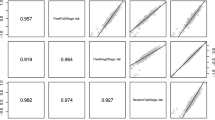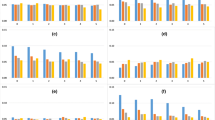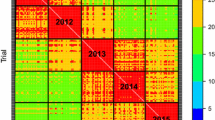Abstract
An important trait in crop cultivar evaluation is stability of performance across environments. There are many different measures of stability, most of which are related to variance components of a mixed model. We believe that stability measures assessing yield risk are of particular relevance, because they integrate location and scale parameters in a meaningful way. A prerequisite for obtaining valid risk estimates is an appropriate model for the distribution of yield across environments. Multienvironment trials (MET) are often analyzed by mixed linear models, assuming that environments are a random sample from a target population, and that random terms in the model are normally distributed. The normality assumption may not always be tenable, and consequently, risk estimates may be biased. In this article, we suggest a transformation approach based on the Johnson system to cope with nonnormality in mixed models. The methods are exemplified using an international wheat yield trial. The importance of accounting for nonnormality in risk analyses based on MET is emphasized. We suggest that transformations should be routinely considered in analyses to assess risk.
Similar content being viewed by others
References
Bullock, J. M. (1999), “Using Population Matrix Models to Target GMO Risk Assessment,” Aspects of Applied Biology, 53, 205–212.
Chou, Y.-M., Turner, S., Henson, S., and Meyer, D. (1994), “On Using Percentiles to Fit Data by a Johnson Distribution,” Communications in Statistics, B, 23, 341–354.
Cullis, B. R., Thomson, F. M., Fisher, J. A., Gilmour, A. R., and Thompson, R. (1996), “The Analysis of the NSW Wheat Variety Data Base. II. Variance Component Estimation,” Theoretical and Applied Genetics, 92, 28–39.
DeGroot, M. H. (1989), Probability and Statistics (2nd ed.), Reading, MA: Addison-Wesley.
Denis, J. B., Piepho, H. P., and van Eeuwijk, F. A. (1997), “Modelling Expectation and Variance for Genotype by Environment Data,” Heredity, 79, 162–171.
De Silva, H. N., Lai, C. D., and Ball, R. D. (1997), “Fitting S B Distributions to Fruit Sizes with Implications for Prediction Methods,” Journal of Agricultural, Biological, and Environmental Statistics, 2, 333–346.
Eskridge, K. M. (1990), “Selection of Stable Cultivars Using a Safety First Rule,” Crop Science, 30, 369–374.
Eskridge, K. M., and Mumm, R. F. (1992), “Choosing Plant Cultivars Based on the Probability of Outperforming a Check,” Theoretical and Applied Genetics, 84, 894–900.
Frensham, A. B., Cullis, B. R., and Verbyla, A. P. (1997), “Genotype by Environment Variance Heterogeneity in a Two-Stage Analysis,” Crop Science, 53, 1373–1383.
Gilmour, A. R., Cullis, B. R., and Verbyla, A. P. (1997), “Accounting for Natural and Extraneous Variation in the Analysis of Field Experiments,” Journal of Agricultural, Biological, and Environmental Statistics, 2, 269–293.
Gilmour, A. R., Thompson, R., and Cullis, B. R. (1995), “Average Information REML, an Efficient Algorithm for Variance Parameter Estimation in Linear Mixed Models,” Biometrics, 51, 1440–1450.
Johnson, N. L. (1949), “System of Frequency Curves Generated by Method of Translation,” Biometrika, 36, 149–176.
Johnson, N. L., Kotz, S., and Balakrishnan, N. (1994), Continuous Univariate Distributions (2nd ed.), volume 1, New York: Wiley.
Lindstrom, M. J., and Bates, D. M. (1990), “Nonlinear Mixed Effects Models for Repeated Measures Data,” Biometrics, 46, 673–687.
McCulloch, C. E., and Searle, S. R. (2001), Generalizes, Linear, and Mixed Models, New York: Wiley.
Mead, R., Riley, J., Dear, K., and Singh, S. P. (1986), “Stability Comparison of Intercropping and Monocropping Systems,” Biometrics, 42, 253–266.
Piepho, H. P. (1996), “A Simplified Procedure for Comparing the Stability of Cropping Systems,” Biometrics, 52, 378–383.
Piepho, H. P. (1997), “Analyzing Genotype-Environment Data by Mixed Models with Multiplicative Effects,” Biometrics, 53, 761–766.
Piepho, H. P. (1998), “Methods for Comparing the Yield Stability of Cropping Systems—A Review,” Journal of Agronomy and Crop Science, 180, 193–213.
Piepho, H. P. (2000), “Exact Confidence Limits for Covariate-Dependent Risk in Cultivar Trials,” Journal of Agricultural, Biological, and Environmental Statistics, 5, 202–213.
Piepho, H. P., Denis, J. B., and van Eeuwijk, F. A. (1998), “Predicting Cultivar Differences Using Covariates,” Journal of Agricultural, Biological, and Environmental Statistics, 3, 151–162.
Piepho, H. P., and van Eeuwijk, F. A. (2002), “Stability Analysis in Crop Performance Evaluation,” in Crop Improvement. Challenges in the Twenty-First Century, ed. M. S. Kang, New York: Haworth Press, pp. 315–351.
Pinheiro, J. C., and Bates, D. M. (1995), “Approximations to the Log-likelihood Function in the Nonlinear Mixed Effects Model,” Journal of Computational and Graphical Statistics, 4, 12–35.
Sheiner, L. B., and Beal, S. L. (1985), “Pharmacokinetic Parameter Estimates From Several Least Squares Procedures: Superiority of Extended Least Squares,” Journal of Pharmacokinetics and Biopharmaceutics, 13, 185–201.
Shukla, G. K. (1972), “Some Statistical Aspects of Partitioning Genotype-Environmental Components of Variability,” Heredity, 29, 237–245.
Siekierski, K. (1992), “Comparison and Evaluation of Three Methods of Estimation of the Johnson S B Distribution,” Biometrical Journal, 34, 879–895.
Slifker, J. F., and Shapiro, S. S. (1980), “The Johnson System: Selection and Parameter Estimation,” Technometrics, 22, 239–246.
Taylor, J. M. G., Cumberland, W. G., and Xiangyi, M. (1996), “Components of Variance Models with Transformations,” Australian Journal of Statistics, 38, 183–191.
Verbeke, G., and LeSaffre, E. (1996), “A Linear Mixed-Effects Model with Heterogeneity in the Random-Effects Population,” Journal of the American Statistical Association, 91, 217–221.
Vonesh, E. F., and Chinchilli, V. M. (1997), Linear and Nonlinear Models for the Analysis of Repeated Measurements, New York: Marcel Dekker.
Wolfinger, R.D. (1993), “Covariance Structure Selection in General Mixed Models,” Communications in Statistics, A 22, 1079–1106.
Author information
Authors and Affiliations
Corresponding author
Rights and permissions
About this article
Cite this article
Piepho, HP., McCulloch, C.E. Transformations in mixed models: Application to risk analysis for a multienvironment trial. JABES 9, 123–137 (2004). https://doi.org/10.1198/1085711043569
Received:
Revised:
Issue Date:
DOI: https://doi.org/10.1198/1085711043569




